Rosie the Riveter: The Origins of the American Icon
ROSIE THE RIVETER DAY
“We Can Do It” has been a long-standing mantra for American women in the workforce. March 21st, which is Rosie the Riveter Day, has brought much-needed attention to womens’ rights and gender inequality over the years. On this holiday, women everywhere celebrate by wearing red bandanas and by posing with their sleeves rolled up–signaling their readiness to work. This is to honor the legacy of women workers during WWII. By working in shipyards, factories and other nontraditional fields, they opened new doors for women–all while supporting the war effort. Simply put, they were trailblazers.
Rosie the Riveter, although a beloved icon of the era, was not made to commend the women of the time, however. She was–in fact–a marketing strategy crafted by the government. Although Rosie serves as a symbol now–reminding us of the extraordinary things women can do–she was first propaganda. Regardless, she has become the face of the greater womens’ rights movement. Rosie’s encouraging message, “We Can Do It,” has persisted through decades of gender inequality, and her stalwart spirit inspires women to fight for justice in modern society. And with March being Women’s History Month, it’s only fitting that we recognize her significance today. For Rosie the Riveter Day, let’s celebrate Rosie’s impacts on American women and uncover her true origins.
THE NEED FOR WOMEN IN THE WORKFORCE
The scale of WWII set it apart from any conflict in human history. The demand for soldiers on the battlefield was higher than it had ever been before. In 1942, the Bureau of Labor Statistics realized that this would pose a problem in American society. There were only a few hundred thousand boys who were pre-draft age, which meant that unless action was taken, a shortage of six million workers would bring the country’s productivity to a standstill. As men left for war, industrial voids would be left behind. The choices were to either recruit women to fill the positions or suffer an economic meltdown.
To avoid stagnation in the country’s productivity, President Roosevelt turned to the federal propaganda agency for help. He proposed that this agency, the Office of War Information, begin a campaign to convince women to work during wartime. With that, the OWI started enlisting artists and American media to create the marketing strategy of a century.
THE BIRTH OF AN AMERICAN ICON
In 1942, an advertising agency hired J. Howard Miller to paint a series of posters for the Westinghouse Electric and Manufacturing Company. The image of the denim-clad riveter was born. His posters were first featured in newspapers and shops to encourage women to apply for jobs at Westinghouse factories. Later, they were hung up within the facilities to increase production, boost morale and prevent strikes. Much like the well-known “We Can Do It” painting, each poster had its own message for the women workers. What Miller didn’t know was that one of his pieces would become an American archetype.

Miller was hired to paint a series of posters for the Westinghouse Company. This became his most famous piece.
While the model behind the “We Can Do It” poster is currently contested, the painting is likely in the image of Naomi Parker Fraley or Geraldine Doyle. Before Doyle died in 2010, she came forward claiming that she was the woman in the photograph that inspired Miller’s poster. However, new evidence has suggested that Parker Fraley, who passed away in 2018, may be the factory worker whose picture circulated in magazines in 1943.
HOW ROSIE THE RIVETER GOT HER NAME
Early in 1943, a song performed by The Four Vagabonds debuted on American radio. “Rosie the Riveter,” written by Redd Evans and John Jacob Loeb, described the new wave of women working to support their country during wartime. Their lyrics told the story of the female factory workers who were “part of the assembly line…making history, working for victory.” The writers chose the name “Rosie” to create alliteration. Once the song was popular, the name went down in history.
Rosie the Riveter then became synonymous with any and all female faces in the propaganda aimed at recruiting women workers. In 1943, Norman Rockwell painted a hard-working woman stomping her foot on Hitler’s Mein Kampf. This form of Rosie was used to advertise war bonds by the U.S. Treasury Department. Many other depictions of Rosie the Riveter followed, but all included the famous denim coveralls and red headpiece.

Rockwell’s illustration features a brawny woman taking her lunch break with a rivet gun on her lap.
ROSIE’S IMPACT ON WOMEN OVER TIME
As Rosie the Riveter’s popularity grew, so did the number of women in the workforce. Between 1940 and 1945, the female percentage of the U.S. workforce increased from 27% to nearly 37%. By 1945, one out of every four married women worked outside the home. Industries like aviation and munitions saw incredible increases in the number of female workers.
Unfortunately, factories fired most women to make room for men again after the war ended. The culture of the late 1940s and 1950s asserted that–at the end of the day–these jobs still belonged to men. The women who had kept the American industry alive were snubbed by the very soldiers they had been working to support. Regardless, women had proven that they were just as capable as their male counterparts. This would lead to the normalization of women in the workforce within a few decades.
Throughout the late twentieth century, the meaning behind the Rosie the Riveter image evolved as women continued to strive for freedom from societal norms. In the 1970s, feminists rediscovered Rosie the Riveter and turned the WWII-era propaganda into a symbol of female empowerment and solidarity. Although Miller and Rockwell originally depicted Rosie as a white, American woman, her spirit has now transcended race, ethnicity and socioeconomic status. Many have used Rosie as inspiration for banners in contemporary womens’ rights movements. Additionally, she has been the face of difficult conversations, like those concerning the gender pay gap or the glass ceiling. She has been a significant icon over the years, and her message encourages women to push back against sexist policies, attitudes and environments.

Rosie’s spirit has now transcended race, ethnicity and socioeconomic status. She is a symbol for women everywhere.
HOW TO BE LIKE ROSIE
On Rosie the Riveter Day, let’s commend women everywhere for persistently showing up–even when doors were closed to them. Historically, the female community has been excluded from certain fields and positions. As they continue to make progress in these spaces, let’s accept and respect them. We must encourage and support women, much like Rosie does with her “We Can Do It!” rallying cry. And as women break through barriers in the business world, the sphere of science, and the military, we must listen to their voices. As we do at Charlie Mike, we must familiarize ourselves with the struggles women face, including sexual assault and harassment, and we must promise to aid them in solving these problems.
Rosie the Riveter reminds us that women can do it, women have done it and women will continue to do it. In the spirit of Women’s History Month and Rosie the Riveter Day, be like Rosie. Take the time to applaud a woman in your life today.




